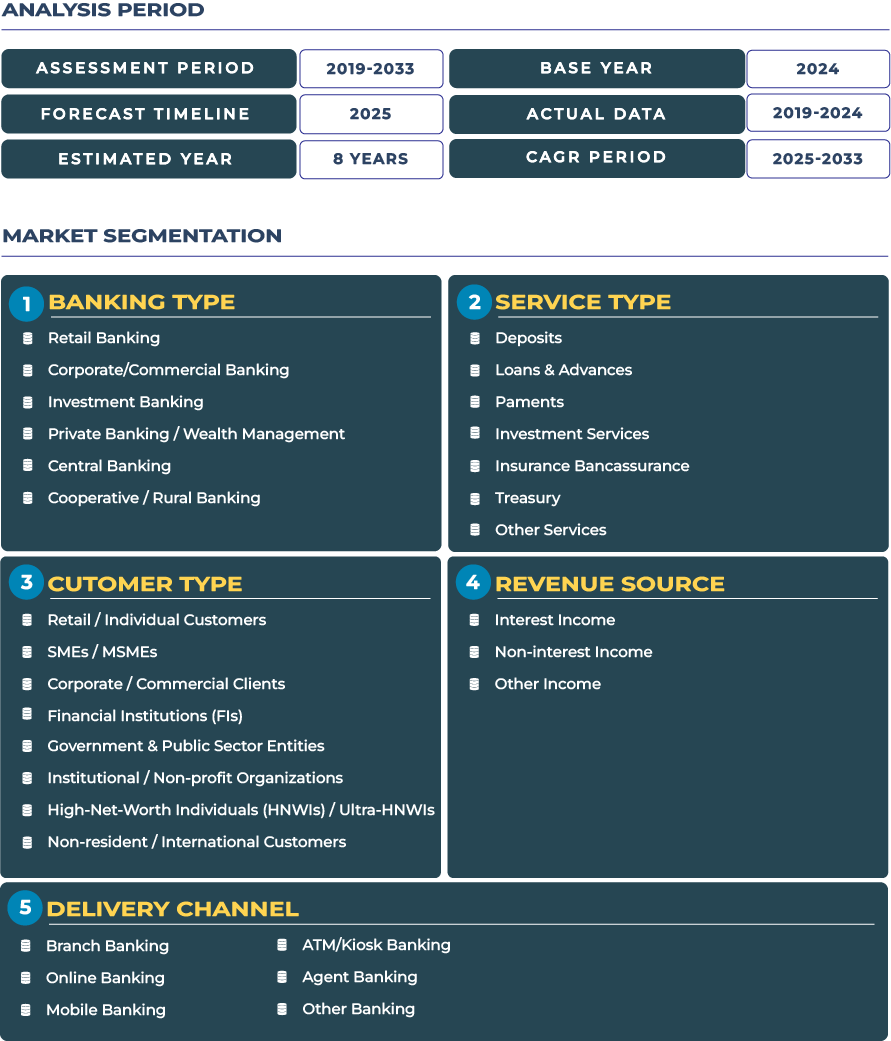Taiwan Banking Market: Cloud-Native Digital Acceleration Powers Instant Payments and Lifestyle Banking Bundles
Taiwan banking sector is executing a rapid digital acceleration built on cloud-native platforms, instant payment rails, and lifestyle-banking bundles that integrate payments, insurance, and premium services. Anchored by a sophisticated payments ecosystem and high digital penetration among consumers and corporates, Taiwan is moving from incremental digitization to platform-based financial services. This transition is emphasizing modular microservices, API-first strategies, and AI-enabled personalization that enable banks to deliver contextual financial products across digital touchpoints-positioning Taiwan as a competitive hub for data-driven transaction banking and premium retail experiences in East Asia.
Note:* The banking market size refers to the total revenue generated by banks through interest income, non-interest income, and other ancillary sources.
Market Outlook: How Cloud-Native Digital Acceleration and Instant Payment Interoperability Will Expand Taiwan Banking Market Through 2033
The Taiwan banking market is projected to expand from USD 62.2 billion in 2025 to USD 93.8 billion by 2033, reflecting a compound annual growth rate of 5.3% from 2025 to 2033. This trajectory is supported by several interlocking forces: the country’s rapid adoption of cloud-native core banking architectures that reduce time-to-market for new products; high consumer affinity for instant and contactless payments that drive transaction volumes; and growing demand for personalized banking bundles that merge payments, lending, wealth services, and lifestyle benefits.
Cloud migration is enabling faster deployments of microservices and real-time analytics, which in turn support instant payment interoperability across domestic and cross-border corridors. Taiwan’s large export-oriented corporate base is driving demand for sophisticated treasury, cash management, and FX solutions that integrate seamlessly with real-time payment rails. Meanwhile, retail demand for lifestyle banking—subscription-based accounts offering concierge services, insurance add-ons, and integrated investment products—is elevating customer lifetime value and providing predictable fee revenues to banks transitioning away from interest-dependent margins.
Geopolitical volatility in the broader region and evolving trade dynamics have made operational resilience and regulatory compliance priorities. Taiwan’s banks are responding by investing in secure cloud architectures, resilient payment switches, and strengthened risk controls to maintain service continuity and regulatory alignment. The combined effect of these trends—product innovation, core modernization, and a supportive regulatory posture—underpins the market outlook through 2033.
Drivers & Restraints: Payment Interoperability and Personalized Product Demand vs. Non-Bank Competition and Fiscal Pressures
Payment Network Interoperability and Demand for Personalized Banking Products Drive Adoption
One of the primary drivers of market expansion is the interoperability of payment networks. The development of interbank instant payment rails and QR-based ecosystems has lowered transaction costs and accelerated payment velocity, which boosts fee income and customer engagement. Banks that implement cloud-native, API-first platforms can rapidly assemble personalized product bundles—combining savings, credit, insurance, and rewards—tailored to segments such as SMEs, gig-economy workers, and digitally native consumers. The shift toward subscription and embedded finance models is enabling banks to capture recurring revenue while deepening customer relationships.
Competitive Landscape: Digital-First Strategies and Cloud Migrations Define Market Leaders
Taiwan’s competitive banking landscape includes major domestic players such as CTBC Financial Holding Group, Fubon Financial, E.SUN Bank, and Bank of Taiwan, alongside international banks with regional operations. CTBC, for example, has been an industry leader in digital product innovation and corporate treasury services and is actively investing in cloud platforms to accelerate product development and cross-border capabilities. E.SUN has built a reputation for agile digital services and customer experience, while Fubon is focusing on wealth management and integrated insurance-banking bundles. These incumbents are increasingly competing on platform capabilities—real-time payments, API ecosystems, and embedded financial services—rather than traditional branch footprints.
New entrants and fintech collaborators are pressuring incumbents to accelerate transformation: digital-only banks and payment platforms are expanding market reach, particularly among tech-savvy consumers and SMEs. Strategic alliances between banks and telcos are also shaping distribution models, enabling broader reach into suburban and rural areas through mobile-first propositions and co-branded financial services.
Conclusion: Cloud-Native Platforms and Integrated Payment Ecosystems Will Define Taiwan’s Banking Competitiveness
Taiwan banking industry is entering a decisive phase in which cloud-native architectures, instant payment interoperability, and lifestyle banking bundles converge to reshape the competitive landscape. Banks that prioritize secure cloud migration and adopt microservices-based platforms will be best positioned to deliver real-time payments, personalized subscription products, and high-margin bundled services. The strategic integration of alternative data via secure APIs will further enable superior credit decisioning, fraud mitigation, and customer engagement.
Regulatory clarity on cloud outsourcing and payment standards is enabling banks to innovate while managing systemic risks. However, competition from non-bank wallets and fiscal constraints underscores the need for banks to diversify revenue through fee-based services, cross-border transaction capabilities, and premium lifestyle offerings. Over the next decade, Taiwan’s banking sector will be judged by its ability to combine technological agility with strong governance—delivering fast, secure, and value-rich financial services that meet the evolving needs of consumers and corporate clients across the region.







